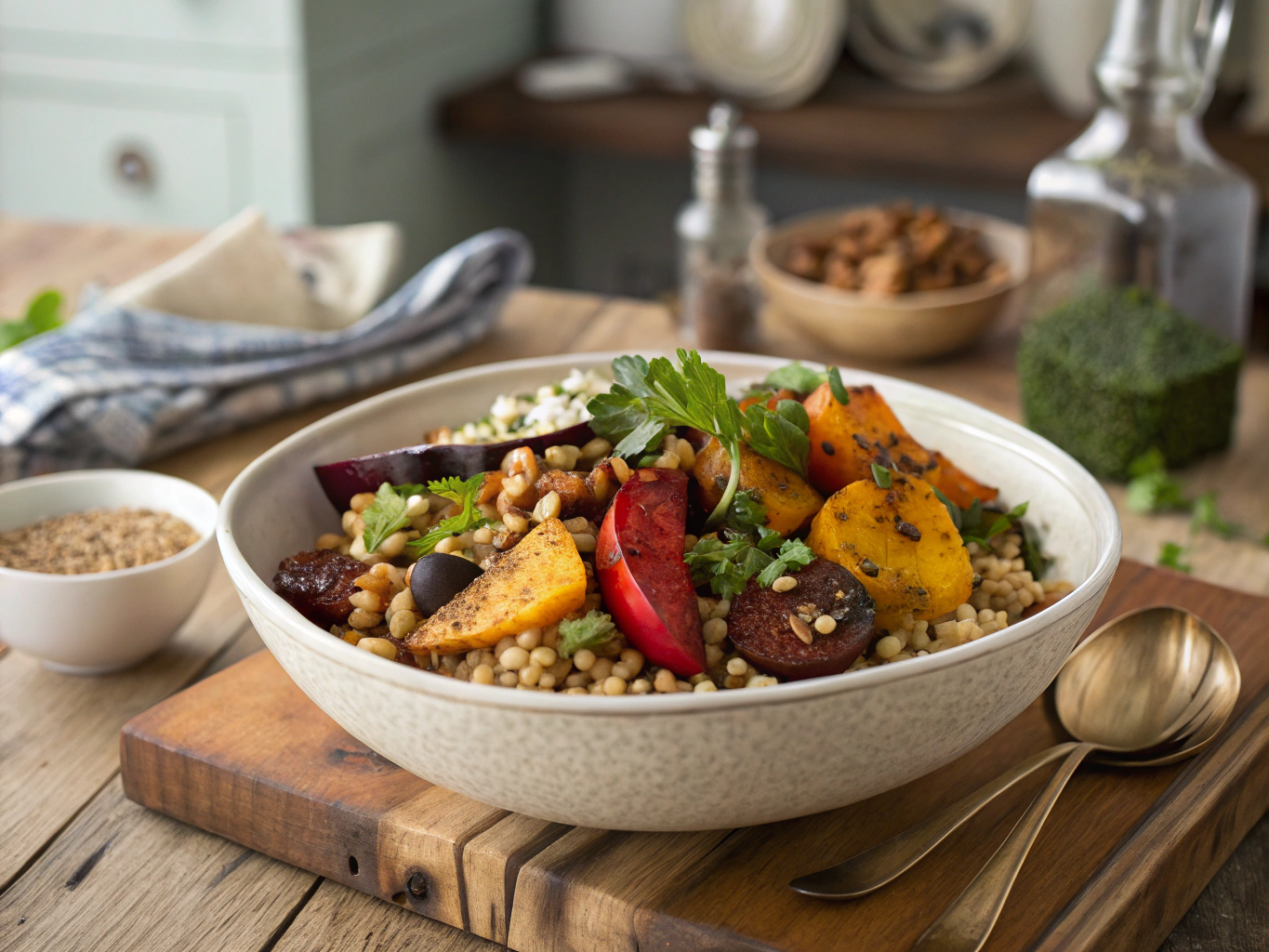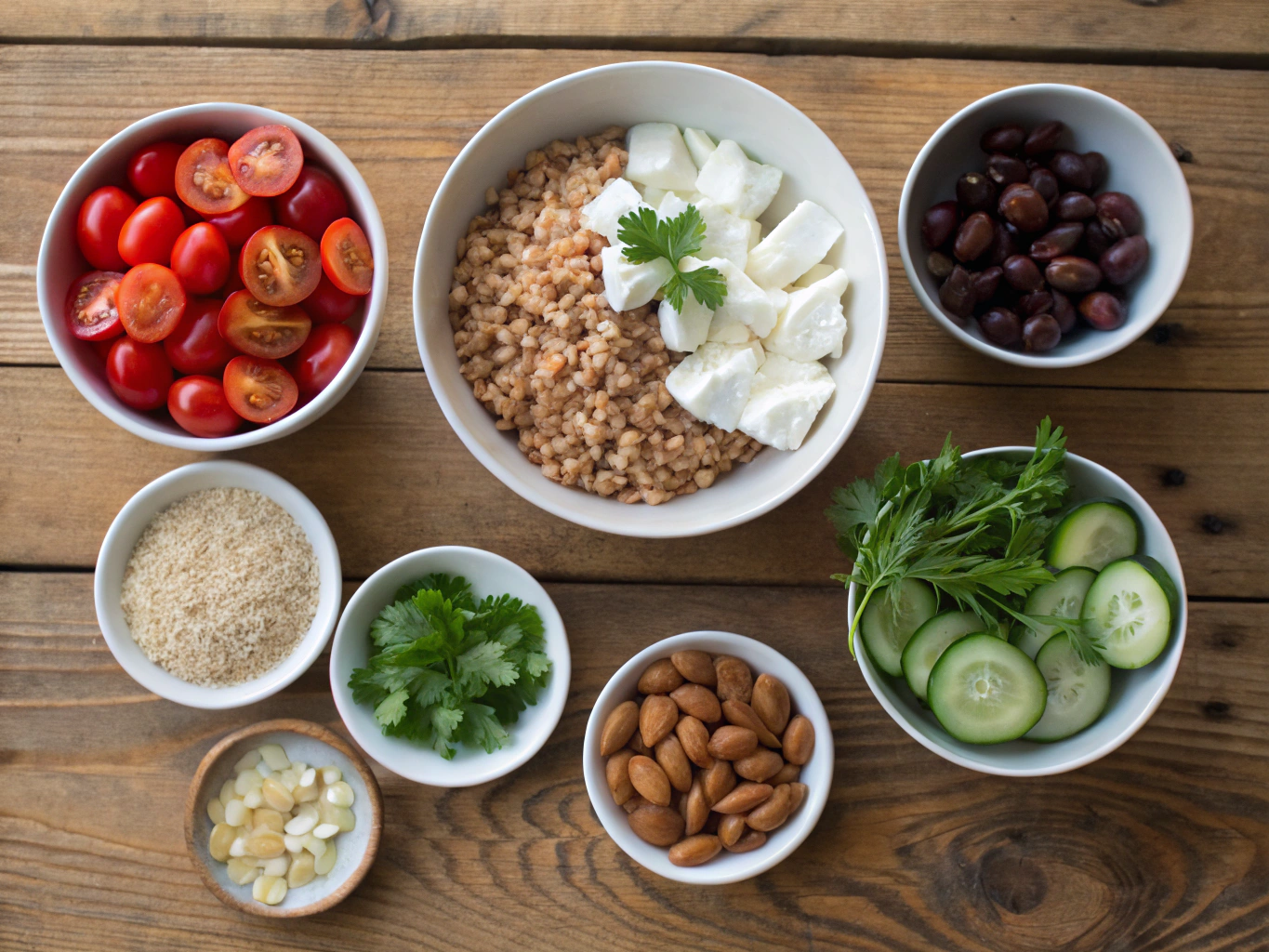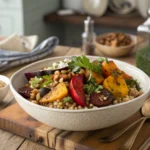
Table of Contents
If you’ve been looking for an earthy, satisfying dish that’s simple to prepare but feels gourmet, farro bowl recipes are about to become your new go-to. In this guide, we’ll explore what makes farro bowls stand out, how to craft your perfect version, and why this ancient grain might just outshine traditional rice. Whether you’re new to plant-based eating or a seasoned home cook, these grain bowls offer flavor-packed comfort you can feel good about.
We’ll start with my own story of how farro came to steal a front spot in my pantry. Then, we’ll dive deep into ingredient guides, prep time, and cooking tips, followed by ways to maximize flavor with mix-ins. We’ll also answer common questions around farro bowl recipes to make sure you’re covered from stove to serving bowl.
A Personal Journey Through Comfort and Farro Bowl Recipes
A Taste of Tradition Reimagined
Growing up in northern California, Sunday dinners were sacred. My family wasn’t fancy, but we appreciated honest food—grains, greens, legumes—from our backyard or the local co-op. After switching to a plant-based lifestyle in my late twenties, I found myself craving something with the same comfort but none of the heaviness. That’s when I rediscovered farro.
I remember the first time I put together a farro grain bowl. I’d just finished a long Saturday at the farmer’s market and came home with bags full of kale, cherry tomatoes, sweet potatoes, and fresh herbs. Tired but inspired, I cooked a batch of farro, roasted the veggies, and tossed everything together with tahini dressing. Something clicked. The subtle nutty bite of farro smoothed out the sweet earthiness of roasted root vegetables. Every spoonful reminded me of the grain-heavy meals of my childhood, but this bowl felt lighter, brighter, and more aligned with how I live now.
From Curiosity to Daily Staple
Since that Saturday, farro bowl recipes have become part of my weekly lineup. Some days I go Mediterranean-inspired with olives, cucumbers, and lemon vinaigrette—very much like this autumn farro salad. Other times, I’ll turn to hearty comfort food, layering roasted mushrooms and lentils, which reminds me of a favorite farro mushroom risotto. With just one grain, possibilities bloom with every season.
What makes farro bowls so satisfying is their adaptability. You can build them with whatever produce you have, and they still feel like a “proper” meal—something hearty enough for dinner, yet clean and energizing. When you’re tired of the same old grain base, farro’s chewy, nutty texture offers a much-needed refresh.
One search for farro bowl recipes online reveals just how much kitchen creativity exists. What I want to share today is not just how to cook a farro bowl, but why this grain might be your next staple, and how to build unforgettable combinations with both flavor and nutrition at the forefront.
Crafting the Perfect Farro Bowl: Ingredients and Instructions
Ingredients List for Farro Bowl Recipes

When it comes to building farro bowl recipes, think of the format as modular. Every bowl typically has these core components:
- 1 cup uncooked farro (whole farro for superior chewiness; pearled if you’re short on time)
- 2 cups vegetable broth or water
- 1 cup roasted vegetables: sweet potato, carrots, cauliflower, or beets
- 1/2 cup crunchy elements: roasted chickpeas, sunflower seeds, or thinly sliced radish
- 1/2 cup raw veggies: cucumbers, arugula, shredded carrot, or cherry tomatoes
- 1/3 cup creamy component: avocado, hummus, or tahini sauce
- Fresh herbs: parsley, cilantro, or dill to brighten up the bowl
- Optional toppings: pickled onions, olives, lemon wedges
Substitutions are easy. Swap sweet potatoes with butternut squash for fall. Try balsamic-marinated mushrooms instead of roasted cauliflower. Or mix in flavored tahini, chimichurri, or even your favorite vegan ranch as the sauce.
Timing
Let’s break down how long it actually takes to get your farro bowl recipes from pantry to plate.
| Step | Time |
|---|---|
| Cooking farro (whole) | 30-35 minutes |
| Roasting vegetables | 25-30 minutes |
| Prep time | 15 minutes |
| Total time | ~60-70 minutes |
Using pearled farro instead? You’ll shave about 15–20 minutes off your cooking time, making it easier for weeknight flexibility.
Step-by-Step Instructions
- Rinse farro under cold water. Combine with broth in a medium pot. Bring to a boil, reduce heat, and simmer. Whole farro takes about 35 minutes; pearled is done in 20. Drain any excess liquid.
- Preheat oven to 400°F. Toss chopped veggies in olive oil, salt, pepper, and your favorite seasoning (smoked paprika and cumin work wonderfully). Roast for 25–30 minutes.
- While the farro and veggies cook, prepare raw ingredient components and sauces. Whip up a creamy tahini-lemon dressing or mash half an avocado with lime.
- Build the bowl: Start with a farro base. Layer your roasted and fresh veggies. Add your creamy or crispy toppings. Garnish generously with fresh herbs and dressing.
- Serve warm or store for a day or two—these bowls actually taste better once ingredients mingle.
For a deeply satisfying variation, try adding flavor-rich broth like in this Italian farro soup or let leftovers turn into a cozy bowl similar to Bartolini farro soup.
Elevating Your Farro Bowls: Flavor & Nutrition Tips
Why Farro is the Grain You Didn’t Know You Needed
Farro is rich in texture and deeper in flavor than rice or quinoa. Its nutty complexity holds up well against rich dressings and roasted veggies. That’s one reason people lean into dishes like farro mushroom recipes—it adds character instead of just serving as a bland base.
From a nutritional standpoint, farro is a powerhouse. It contains more fiber and protein than white rice, according to Harvard’s School of Public Health. It’s also loaded with magnesium, iron, and zinc—micronutrients folks on plant-based diets should intentionally seek.
Seasonal Pairing Ideas
A bowl is only as exciting as what you choose to pair with it. Luckily, the versatility of farro means almost anything goes:
- Spring: asparagus, radishes, snap peas, mint, lemon vinaigrette
- Summer: blistered cherry tomatoes, cucumbers, basil, grilled corn, tzatziki
- Fall: roasted squash, kale, cinnamon-tahini sauce, walnuts
- Winter: mushrooms, caramelized onions, rosemary oil
Looking for warming blends? Adapt your leftovers into comforting versions of Greek lemon chicken farro soup, but keep it plant-based by using chickpeas instead of chicken.
Questions, Nutritional Facts & Final Thoughts on Farro Bowl Recipes
Creative Add-Ons That Wow
Everyone loves a well-built grain bowl, but texture, aroma, and taste matter. Here’s what I always keep in mind:
- Texture: Add crunch with toasted seeds or pickled onions
- Freshness: Toss in chopped herbs minutes before serving
- Umami: Try roasted mushrooms or a splash of tamari in your dressing
- Heat: Optional chili crisp or harissa paste for a subtle kick
Remember, a farro bowl can feel different every single time thanks to its builder-style nature.
If you’re inspired by layered comfort, consider trying versions built around savory broths like our Tuscan farro soup or go back to basics with soothing farro soup recipes.
Storage and Batch Prep
Farro is your meal-prep dream. After cooking, it stores beautifully in the fridge for five days and freezes up to a month. Build bowls from the leftovers, stir it into soups, or re-season for an entirely new taste. Dressings should be stored separately and added just before eating to maintain freshness and texture.
You can also repurpose leftover grains into stir-fries, fritters, or even stuffed peppers. The grain’s structure holds up well under heat, moisture, and refrigeration.
Frequently Asked Questions
What is a farro bowl?
A farro bowl is a plant-based meal featuring farro as the grain base, topped with vegetables, proteins (usually legumes or tofu for vegans), sauces, and garnishes. It’s customizable and often nutrient-dense, designed to be satisfying and healthy.
How do you prepare farro for a bowl recipe?
Rinse farro well to remove any residue. Combine with liquid—typically a 1:2 ratio of farro to water or broth—and simmer until tender. Whole farro takes roughly 35 minutes, while pearled cooks in 20 minutes.
What toppings go well in a farro grain bowl?
Great toppings include roasted or raw veggies, hummus, nuts, seeds, avocado, pickled onion, lemon juice, and chopped herbs. Add flavor and texture with creamy dressings, fermented elements, or spicy sauces like harissa.
Is farro healthier than rice in grain bowl recipes?
Yes, farro often beats white rice in nutritional value. It has more fiber, protein, and micronutrients. Compared to white rice, it’s slower to digest, helping with satiety and blood sugar regulation.
Conclusion
Farro bowl recipes deliver the perfect blend of comfort, flavor, and nutrition. They adapt effortlessly with the seasons, hold up well in meal prep, and give you a canvas to express your kitchen creativity. Whether you’re exploring new plant-based dishes or simply looking for better alternatives to rice, farro bowls are a delicious, wholesome solution that get better with each variation.
Print
Farro Bowl Recipes: Hearty, Healthy, and Utterly Delicious
- Total Time: 60 minutes
- Yield: 2–3 servings 1x
- Diet: Vegan
Description
If you’ve been looking for an earthy, satisfying dish that’s simple to prepare but feels gourmet, farro bowl recipes are about to become your new go-to. These grain bowls offer flavor-packed comfort you can feel good about.
Ingredients
1 cup uncooked farro (whole or pearled)
2 cups vegetable broth or water
1 cup roasted vegetables (sweet potato, carrots, cauliflower, or beets)
1/2 cup crunchy elements (roasted chickpeas, sunflower seeds, or radish)
1/2 cup raw veggies (cucumbers, arugula, shredded carrot, or cherry tomatoes)
1/3 cup creamy component (avocado, hummus, or tahini sauce)
Fresh herbs (parsley, cilantro, or dill)
Optional toppings: pickled onions, olives, lemon wedges
Instructions
1. Rinse farro under cold water and combine with broth in a pot. Bring to a boil, reduce heat, and simmer. Cook whole farro for about 35 minutes, or pearled for 20 minutes. Drain excess liquid.
2. Preheat oven to 400°F. Toss chopped veggies in olive oil, salt, pepper, and seasonings. Roast for 25-30 minutes.
3. While cooking, prep raw veggies and sauces. Make tahini-lemon dressing or mashed avocado with lime.
4. Build the bowl with farro base, then layer roasted and raw veggies, creamy/crunchy toppings, herbs, and dressing.
5. Serve warm or store for up to 2 days for enhanced flavor blending.
Notes
Substitute based on season or pantry. Try squash instead of sweet potatoes or flavored tahini as dressing.
Great for meal prep. Cooked farro stores for 5 days refrigerated or a month frozen. Keep dressing separate until serving.
- Prep Time: 15 minutes
- Cook Time: 45 minutes
- Category: Lunch, Dinner
- Method: Boil, Roast
- Cuisine: Plant-Based, Mediterranean
Nutrition
- Serving Size: 1 bowl
- Calories: 420
- Sugar: 4g
- Sodium: 340mg
- Fat: 14g
- Saturated Fat: 2g
- Unsaturated Fat: 11g
- Trans Fat: 0g
- Carbohydrates: 58g
- Fiber: 8g
- Protein: 12g
- Cholesterol: 0mg
Keywords: farro bowl, grain bowl, vegan, plant-based, meal prep
